How to Fight and Land Big Fish with a Fly Rod
December 8th, 2022
There’s an art to fighting and landing big fish with a fly rod. Don’t let anyone tell you differently. Conventional gear tends to allow you to muscle-in fish, but in most fly angling situations you’ll be limited by relatively weak tippet.
I’ve caught thousands of fish on a fly rod, both big and small, and in the below article I’ll teach you what I’ve learned through experience on the water.
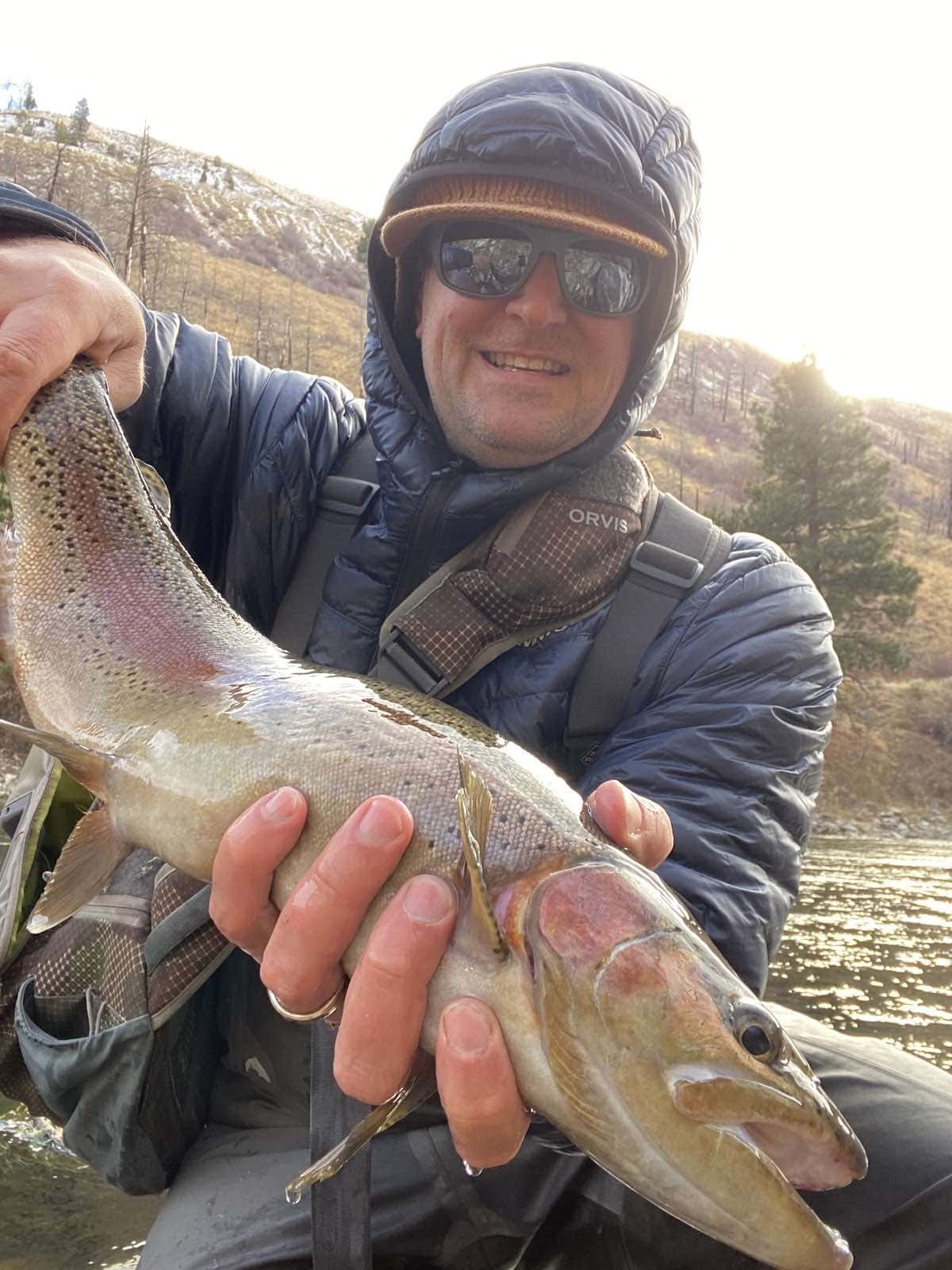
In the above picture, I’m holding a large rainbow trout that I caught on a small dry fly tied to light tippet on a river with strong current. In these types of situations, you need to rely upon technique rather than muscle when attempting to land your fish.
How to Set the Hook when Fly Fishing
Let’s start at the beginning.
There are two types of hook sets in fly fishing: a trout set, and a strip set.
What is a Trout-set?
A trout set is when you simply raise your rod to set the hook. This is the most traditional type of hookset in freshwater fly fishing, but it also happens to be the weakest. This is the method you would generally use when fishing with dry flies, wet flies, and nymphs.
When you engage in a trout set, make sure you’re not ripping the rod back. You want it to be a deliberate but not violent arm movement. Imagine you’re answering the phone and bringing it to your ear–that’s the approximately amount of force to use.
If you use too much force, you’re going to either rip the fly out of the fish’s mouth, or you’ll break your line off (leaving the fly in the fish’s mouth). I know, because I’ve done both many times.
If the line breaks, it’ll usually be right at the fly, or at the knot where you joined your leader and tippet.
What is a Strip-set?
A strip set is when you rigorously pull the fly line itself to set the hook. This is the standard method whenever you’re casting streamers in fresh or saltwater because it’s the strongest hook set, and it also doesn’t pull the fly too far away from the fish if you miss.
Doing a trout set while fly fishing in the salt is a cardinal sin, but it happens occasionally because it’s so instinctual for river and stillwater anglers.
If you doubt me, here’s an experiment you can do that’ll prove my point.
Cut the fly off your line and wrap the end of the line around your finger(s), clutching it tightly. Now have someone else hold your rod and walk about 30-feet away.
At this point, have the person holding the rod do a trout set.
Then, have them do a strip-set.
You’ll feel a very distinct difference.
How to fight big fish
Fighting and landing big fish means using the butt of your fly rod to your advantage. If your rod is doubled-over in an upside down “U”, you’re not applying maximum pressure. It might look like you are, but you’re not. Not even close.
The best way to take control while fighting a fish is to nearly point your rod at the fish, allowing the bend to occur near the butt of your rod (the thickest part). Now, you’re not literally pointing your rod directly at the fish, but around 15-20 degrees to the left or right. This will greatly help in tiring the fish.
You need to apply pressure to big fish if you’re going to land them successfully. You also need to temper the pressure you apply with the diameter of your tippet.
For example, if you’re chasing trout using 6X tippet, you must be more conscientious of how much pressure you’re applying. If you’re in saltwater using 30lb test, you can crank on fish and trust your line.
The longer you fight a fish, the larger the hole will be where the hook is set, which increases the likelihood your fish will throw the fly (ie. the fly will come unpinned).
Also, the longer you fight your fish, the higher the probability the fish will die of exhaustion-related factors.
I’ve heard people say they prefer a lighter rod because it prolongs the length of the fight. I’ll give them the benefit of the doubt and assume they don’t realize how damaging this is to the health of the fish. It’s been estimated by researchers that approximately 30% of catch-and-release fish die simply as a result of being caught. Think about that.
There are other times when a fish’s teeth will unavoidably snap the line. Trout don’t look very toothy, but if you’d like to see how formiddable their teeth look like, read my entitled, “Do trout have teeth?“
Pull then reel down
The tried-and-true method for reeling in fish is to pull, then reel down. Pull, then reel down.
Put another way, you pull the fish towards you, then reel in line as you drop your rod back down towards the fish. Then repeat.
You don’t ever want to simply reel in continuously. Doing this mutes the function of the drag and will allow the fish to break you off much more easily.
Side pressure
You may have heard about “side pressure” when fighting fish. This simply means applying horizontal pressure in the opposite direction the fish is pulling.
So, if your fish goes right, you go left. And vice-versa.
This will tire the fish quickly, as well as keep it off-balance. As a result, you’ll be able to net and release it faster than would otherwise be possible. Always remember that some fish, oftentimes trout, can position themselves within current so that they can actually rest for short periods. Don’t let them rest–keep the pressure on.
Landing a fish quickly and firmly is better for the fish’s health than a less strenuous but prolonged fight. When the fight is long, fatal levels of lactic acid and stress hormones (adrenaline and cortisol) can accumulate within the fish.
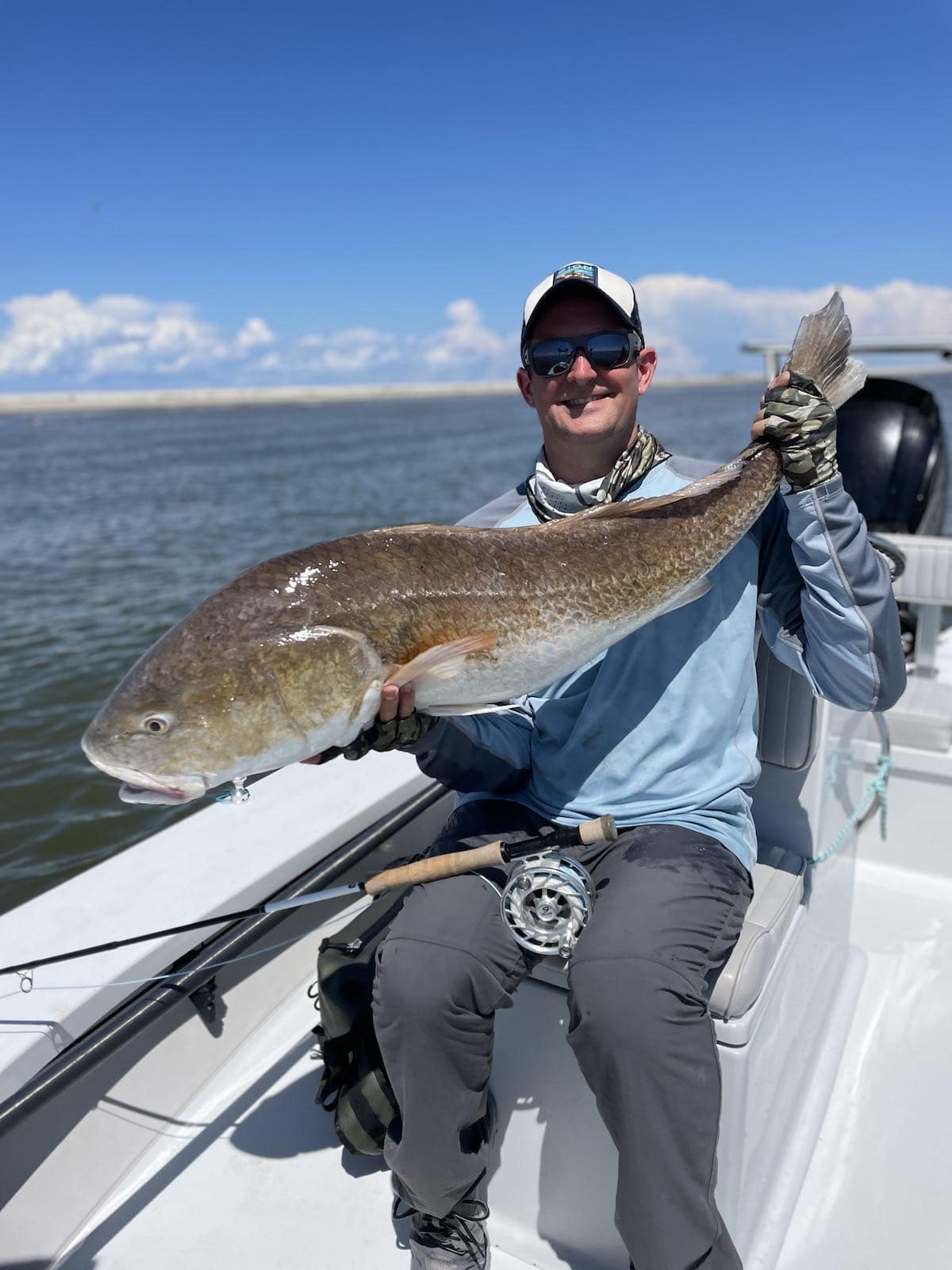
Here’s a picture of a giant redfish I caught and landed in the Gulf of Mexico. I had to trust my gear and knots and apply tremendous pressure to bring this fish to the net. I used side pressure, and let the butt of the 9-weight rod do most of the work.
Landing fish in current
If you’re fighting a strong fish in current, whether that be in a river or a moving tide, get the fish out of the current as quickly as possible. Mature fish expertly use current to their advantage.
In a river, for instance, I always try to pull a big fish towards the shoreline where the current is weaker and the water is shallower. This makes subduing the fish much easier.
Speaking of current, you always want to try to keep the fish upstream of you. Not only does this make netting the fish easier, but it prevents the fish from using the current against you. Once a big fish gets downstream of you, buckle up.
Line strength
It should go without saying that you always want to use the strongest pound test line that you can get away with. Some fish are leader shy (trout), and some aren’t (largemouth bass).
I can tell you from experience that on some rivers, using 6X is a huge advantage over 5X when it comes to hooking fish, even though both line diameters are visible to fish (don’t let anyone tell you differently).
I can also tell you from experience that there’s a big difference in the pressure you can apply to 5X tippet versus 6X tippet. Landing big fish on 6X is much more challenging than on 5X.
This ties back to knowing how to balance the strength of your line and the amount of pressure you can apply.
Slack in your line
When you’re fighting a fish, keep slack out of your line at all costs.
The only exception to this rule is when a fish jumps into the air. If your fish goes airborne, you should “bow to the fish,” as the saying goes. Don’t keep the line tight if the fish has gone aerial.
Once in a while a fish will come directly towards you when you set the hook. The only thing you can (and should) do in this situation is strip the line in as fast as you can. You want to get the line taught as quickly as possible.
Slack in the line allows a fish to throw the hook much more easily. It’s actually amazing how adept they are at taking advantage of just a few seconds of loose line.
I was casting to some bull redfish near the shoreline one day (from a drift boat), and one of the reds took my streamer. I set the hook by doing a firm strip-set, and the fish bolted directly at me.
I stripped-in line as furiously as I could, but within those few precious seconds the fish threw my fly.
Landing fish in saltwater
Keeping fish out of rocks and coral is paramount. If you’re clearn of these types of obstacles and you’ve got a big fish on your line, use the ocean’s waves to help pull the fish up onto the shoreline. It takes a little timing, but is hugely advantageous.
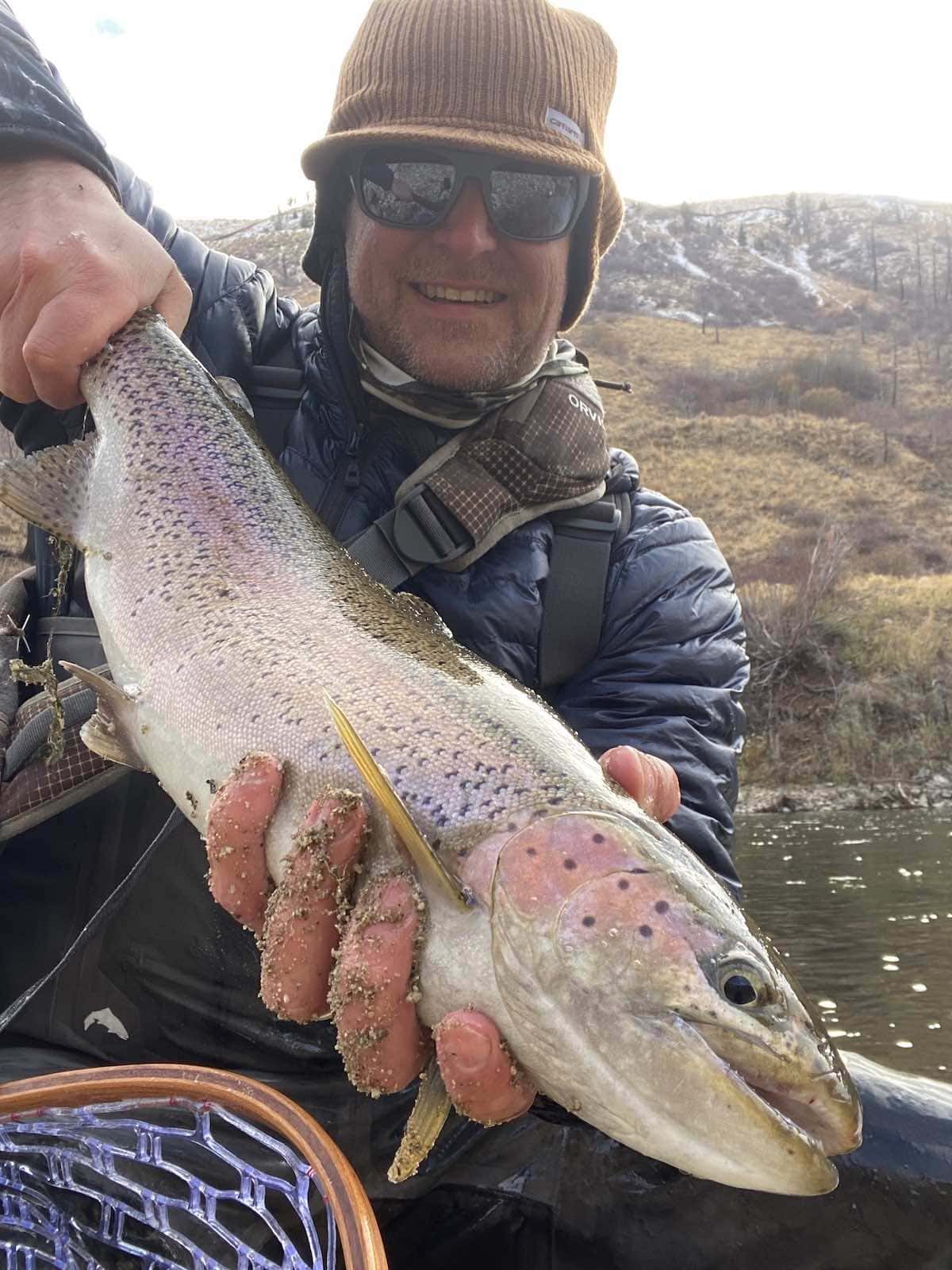
Here’s another brute rainbow trout that rose to my dry fly in November. It takes some concentration and proper line and reel management, but fish like this can be landed more often than not, even on light tippet.
Using a fly fishing net
Here’s a rule I’ve learned through experience: Any time I think I won’t need my net, I end up needing it.
When you look at your net while you’re gearing up, you may be tempted to leave it in the vehicle. Don’t do it.
You’ll want a net that has soft rubber netting–avoid using the string netting versions since they tend to be a little rougher on the fish’s slime coat, and your fly hook will get caught in the netting more often.
When you’ve got your fish within reach, grab your net with one hand and hover your net just above the water’s surface. Don’t dunk it into the water because it’ll spook the fish. Yes, the fish can see the net above the water too, but it’s not as alarming as when the net is in the water with the fish.
Pull the fish up towards the surface and try to keep the fish’s head right at the surface. This makes it more difficult for the fish to make a sudden bolt away. Slowly pull the fish towards your net, and when the fish is close, dip your net into the water and scoop-up the fish head-first.
Don’t lift your fly rod too high when you’re in the act of netting a fish. This puts a lot of extra tension on the leader and can have consequences. I’ve lost plenty of fish right at the net because of this, so I trained myself not to do it.
Reeling the leader into your rod guides
Saltwater fly anglers have no problem reeling their leader up into their fly rod guides when they’re getting ready to land a fish, but the thought of it makes me recoil. Their leaders are much stronger than a standard trout leader, so they can afford to be more aggressive.
The danger is that the fish may go on another run and the connection where your fly line and leader are joined will get caught in the guides and the fish will instantly break you off.
Complicating matters is that trout anglers often like to use leaders that are 12-15 feet in total length. This means you almost have to bring your leader partially into your rod guides in order to get a fish close enough to net.
It’s food for thought. Every fly fisher needs to make their own judgment.
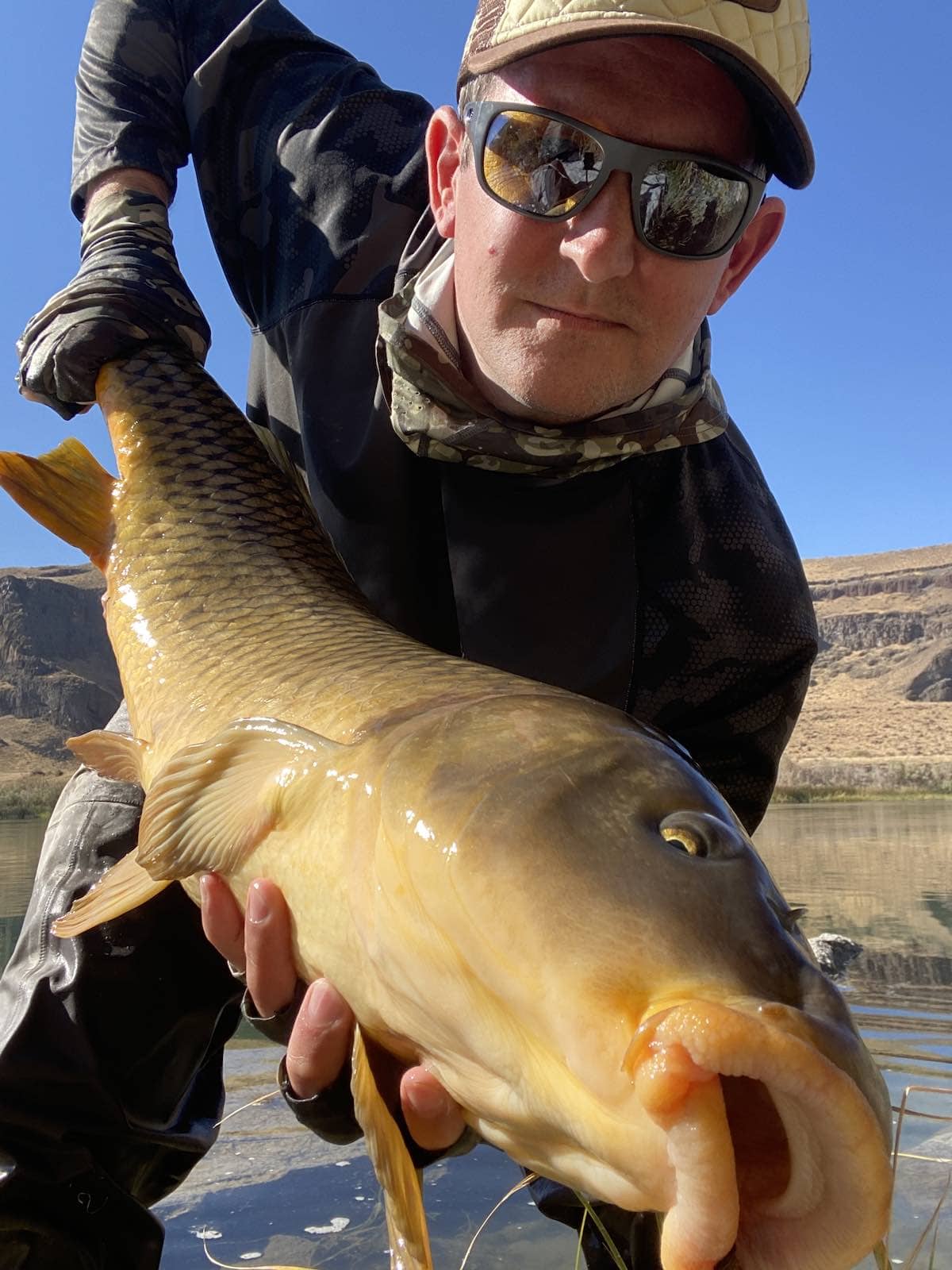
Here’s a massive carp I landed on a 5-weight fly rod with 5X tippet.
What is “putting a fish on your reel?”
The phrase, “putting a fish on your reel” simply means that you are bringing the fish in using your reel, rather than stripping in line.
For most freshwater fly fishers, a reel is almost ornamental because most fish can (and should) be stripped-in.
The only time you would put a fish on your reel is if it was taking out line and you wanted to have a drag system ready. It’s much more common in saltwater angling, but a rainbow that’s 17+ inches will often require this as well.
Don’t miss my article on how to fly fish for rainbow trout.
Will I lose a Fish if I use barbless hooks?
The truth is, using barbless hooks will result in your losing a few more fish than you otherwise would. However, hooks without barbs are much easier to remove once you net your fish, and they’re much less damaging to a fish’s mouth. In short, the benefits outweight the negatives and I highly recommend using barbless hooks.
How to remove a hook from a trout
Ideally, you’ll be able to keep your trout submerged in water from the time you net it, to the time you release it. This is done by keeping the fish in the net, and keeping the net in the water.
Reach into the net and carefully remove the hook as you would with any other fish. Use hemostats or forceps if the hook is difficult to remove, but use these tools gently. Anglers have a tendency to really crank on hooks when using tools.
If the fish is still actively trying to escape, try turning the trout upside-down. This often calms the fish, and works with a variety of species, even sturgeon.
Avoid touching the fish’s gills at all costs.
If the fly is lodged too deeply in the fish’s throat, or you simply can’t get at the fly, just cut the leader as close to the fly as possible. This gives the fish a much better chance of survival. The fish’s body will push the hook out after a few days. This seems like a strange concept, but it’s true.
Will My Fly Rod Break?
Your fly rod isn’t fragile–it’s literally manufactured to bend into a “U” shape without issue. So, don’t worry about breaking your rod while fighting a fish. You’re much more likely to break your rod in a car door.
Remember, you don’t want to fight a fish with your rod shaped like a “U,” you want to point your rod towards the fish and use the butt of the rod to apply pressure. This makes breaking your rod nearly impossible.
Most rod manufacturers have excellent warranties and will repair your rod for a nominal fee. The only rod I’ve ever broken was when I was putting my rod back into my vehicle. The tip caught on something and snapped. It was a Winston rod, and for $75 it was repaired and back to me within six weeks.
Here’s an article I wrote on the best fly rod warranties.
Your Fly Reel’s Drag Setting
Unless you’re using a click and pawl reel, your fly reel’s got a drag setting and it’s important you understand how to use it.
Most modern fly reels have a small knob on the axis of the reel that allows you to dial the drag up or down as needed. For example, I keep my Sage trout reel at a #6 setting (out of 20) when I’m casting to rainbow, brown, and brook trout.
Your average trout isn’t going to take out line, you’ll just strip the fish in, but when you hook into something bigger you want to be prepared.
If a fat rainbow starts peeling-off line, I’ll instantly dial my drag up to a #8 setting, which slows (and wears) the fish down.
When I hooked into a monster +/-30lb carp a couple months ago, I dialed the drag up to #12 while it went on a screaming run out to deeper water.
Learning to adjust your drag on-the-fly is an important, yet simple, skill to master. It’ll help you land more fish.
Summary
Hooking into big fish is exciting, but landing them is exhilirating. It provides you with a feeling of accomplishment, and being able to observe the fish closely never loses its appeal.
We’ve covered how to pull then reel down, how to apply side pressure, effective drag management, and how to use the net properly.
It’s my hope that you’ll use these techniques to land more fish!
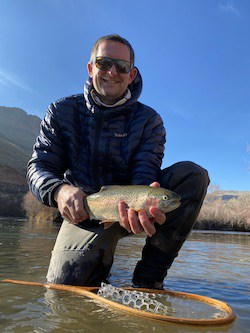
About the Author
My name's Sam and I'm a fly fishing enthusiast just like you. I get out onto the water 80+ times each year, whether it's blazing hot or snow is falling. I enjoy chasing everything from brown trout to snook, and exploring new waters is something I savor. My goal is to discover something new each time I hit the water. Along those lines, I record everything I learn in my fly fishing journal so I can share it with you.
Follow me on Instagram , YouTube, and Facebook to see pictures and videos of my catches and other fishing adventures!


